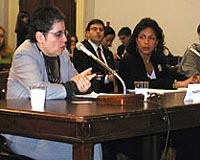| . |  |
. |
Seoul (UPI) Jun 29, 2009 South Korea announced an update of its national defense plan, including an increased potential to hit North Korea's military assets. South Korean President Lee Myung-bak announced the refinements to the National Defense Reform 2020 plan that Seoul established in 2005. Since then, however, North Korea has become a nuclear power, and diplomatic moves, many initiated by Lee, have been met with additional threats from the North. Pyongyang on May 25 carried out an underground nuclear test and has warned foreign shipping to stay away from its coasts for the next two weeks because of possible live fire military tests. Some intelligence sources said North Korea is preparing a long-range missile test that is expected to be fired toward Hawaii. It is unlikely that Pyongyang has the technical wherewithal to reach the United States, but South Korea faces a much more real threat with a massive army poised on its northern border supported by thousands of artillery tubes. And Pyongyang has been saber-rattling of late, saying any interference with its programs would be seen as an act of war. Lee traveled to Tokyo for talks Sunday with Japanese Prime Minister Taro Aso, whose country is also within Pyongyang's missile range. Lee said the North's actions represent "serious security threats" and are "absolutely unacceptable." "We will never tolerate a nuclear-armed North Korea," Lee said at a news conference. Lee's comments support South Korea's revamped national defense plan, details of which were made public Friday. The plan, expected to cost about $460 billion, calls for "stemming and eliminating to the maximum degree" threats posed by North Korea's military capabilities, the South Korean Yonhap news agency reported. Yonhap quoted an unnamed senior official involved in the development of the defense plan as saying, "If it becomes clear that North Korea is moving to hit us with nuclear and missile arsenal, we will hit its bases as quickly as possible to prevent launches no matter where they are." Most of the new aspects of the plan involved upgrades in equipment and technology. South Korea said it would have 28 army divisions, unless an emergency develops, in which case an additional 10 divisions of reserves would be called upon. There would be a reduction in the number of active-duty personnel. However, Seoul is looking to substantially increase its hardware, including artillery deemed necessary to stop a potential North Korean long-range bombardment from just north of the demilitarized zone. South Korean defense officials are also looking to add intelligence-gathering assets, including satellites, early warning aircraft and unmanned drones. Improvements in missile defense systems are planned. The South Korean Defense Ministry said it may upgrade its antimissile capability with the PAC-3 missile interceptor system, made by U.S. company Lockheed Martin, and SM-3 and SM-6 missiles, manufactured by Raytheon, another U.S. company. Those are part of a system designed to thwart incoming missile attacks. All are to be in place in 11 years, the same timeframe set out in the 2005 version of the National Defense Reform 2020. South Korean officials stressed any action against the North would depend on signs of an impending attack by Pyongyang. However, should "unusual movement" be detected, South Korean aircraft would be ordered to target areas of greatest threats, the new plan says. North Korea has yet to react to the South's change in defense plans and has continued to use its state media to blame the United States for Pyongyang's military moves. North Korea has long stated a fear of an American invasion. Share This Article With Planet Earth
Related Links Learn about nuclear weapons doctrine and defense at SpaceWar.com Learn about missile defense at SpaceWar.com All about missiles at SpaceWar.com Learn about the Superpowers of the 21st Century at SpaceWar.com
 New North Korea sanctions will have impact: US
New North Korea sanctions will have impact: USWashington (AFP) June 28, 2009 New UN sanctions intended to force North Korea to abandon its nuclear program will have an "impact" when they take full force, US ambassador to the United Nations Susan Rice said Sunday. "When this resolution is fully enforced -- not only in terms of potential vessels that may be violating the sanctions but the financial sanctions, the arms embargo, the assets freezes -- this will be a very ... read more |
|
| The content herein, unless otherwise known to be public domain, are Copyright 1995-2009 - SpaceDaily. AFP and UPI Wire Stories are copyright Agence France-Presse and United Press International. ESA Portal Reports are copyright European Space Agency. All NASA sourced material is public domain. Additional copyrights may apply in whole or part to other bona fide parties. Advertising does not imply endorsement,agreement or approval of any opinions, statements or information provided by SpaceDaily on any Web page published or hosted by SpaceDaily. Privacy Statement |